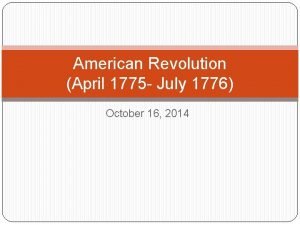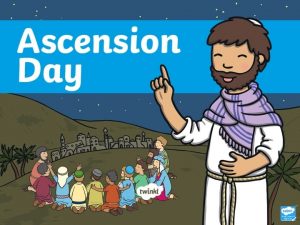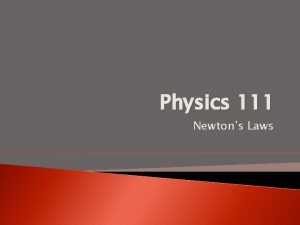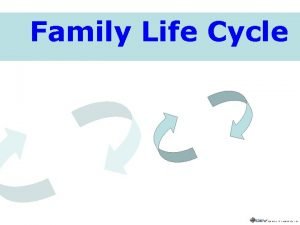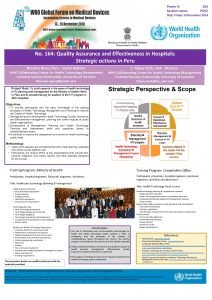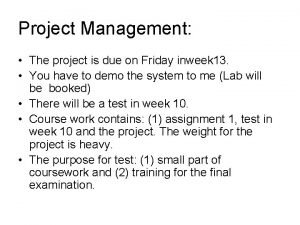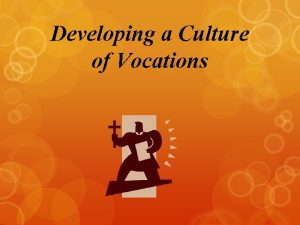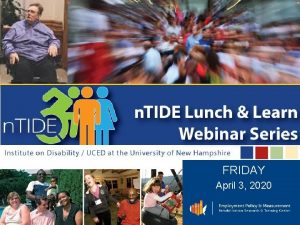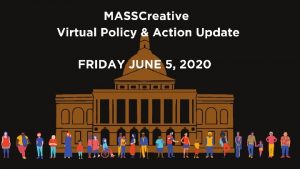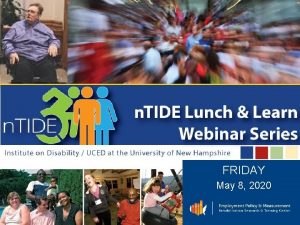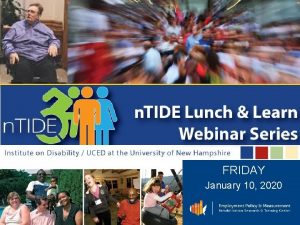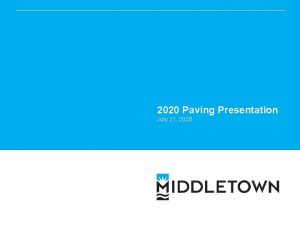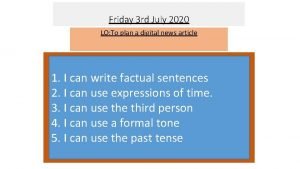FRIDAY July 2 2020 FRIDAY July 2 2020














































- Slides: 46

FRIDAY July 2, 2020

FRIDAY July 2, 2020

#n. TIDELearn Up Front Matters • This webinar is being recorded. We will post an archive of each webinar, each month, on our website at www. researchondisability. org/n. TIDE. This site will also provide copies of the presentations, the speakers’ bios, full transcripts, and other valuable resources. • As an attendee of this webinar, you are a viewer. To ask questions of the speakers, click on the Q & A box on your webinar screen and type your questions into the box. Speakers will review these questions and provide answers during the last section of the webinar. Some questions may be answered directly in the Q & A box. 3

#n. TIDELearn Up Front Matters • If you have any questions following this recording, please contact us at disability. statistics@unh. edu, or toll free at 866 -538 -9521 for more information. Thanks for joining us. Enjoy today's webinar! 4

#n. TIDELearn Welcome Andrew Houtenville University of New Hampshire 5

#n. TIDELearn Captions are Available • After selecting Closed Caption, pick Show Subtitle and the captions will appear on the bottom. • If you pick View Full Transcript, a running transcript of the captions will appear on the side. • You can adjust the caption size by selecting Subtitle Settings. 6

#n. TIDELearn Up Front Matters • n. TIDE Lunch & Learn: – Occurs at noon Eastern-time on the first Friday of each month, with the release of the n. TIDE Report. – A joint effort of the University of New Hampshire, Kessler Foundation, and the Association of University Centers on Disability (AUCD). – A part of the Rehabilitation and Research Training Center on Employment Policy and Measurement, which is funded by the National Institute on Disability, Independent Living and Rehabilitation Research (NIDILRR), grant no. 90 RT 0537. 7

#n. TIDELearn Today’s Program • Part 1: n. TIDE Report … “The Numbers” – Andrew Houtenville, University of New Hampshire – John O’Neill, Kessler Foundation • Part 2: n. TIDE News – Denise Rozell, Association of University Centers on Disabilities (AUCD) • Part 3: Guest Speaker – Charles Catherine, National Organization on Disability • Part 4: Q&A … for Parts 1 -3 8

#n. TIDELearn Part 1 The n. TIDE Report John O’Neill Kessler Foundation 9

#n. TIDELearn The Monthly n. TIDE Report • The monthly n. TIDE Report is a press release and infographic, looking at the latest employment statistics. • Uses data from the “jobs report” released by the U. S. Bureau of Labor Statistics, on the 1 st Friday of each month. 10

#n. TIDELearn Source of the Data • U. S. BLS, Current Population Survey (CPS). – Source of the “official” unemployment rate. • Civilians, ages 16 -64, not living in institutions. • Available September 2008 onward. • Not yet seasonally adjusted. – which is why we compare to the same month last year. 11

#n. TIDELearn The Numbers Andrew Houtenville University of New Hampshire 12

#n. TIDELearn Employment-to-Population Ratio 13

#n. TIDELearn Employment-to-Population Ratio 14

#n. TIDELearn Employment-to-Population Ratio 15

#n. TIDELearn Employment-to-Population Ratio 16

#n. TIDELearn Employment-to-Population Ratio 17

#n. TIDELearn Part 2 n. TIDE News Denise Rozell Association of University Centers on Disabilities (AUCD) 18

#n. TIDELearn Federal Policy Update – COVID 19 Stimulus/Relief Bills • House passed HEROES Act… May 15; • Senate -- Democratic bills introduced June 30: • Coronavirus Child Care and Education Relief Act • $4 billion for career, technical, adult education, and training • $4 billion for the E-Rate Program to close the “homework gap” • $12 billion for the Individuals with Disabilities Education Act (IDEA) • $345 billion for the Education Stabilization Fund • Requires state assurance that students with disabilities have full rights under IDEA/504

#n. TIDELearn Federal Policy Update – COVID 19 Stimulus/Relief Bills • HHS/CMS: • HCBS Funding – Designated FMAP bump for HCBS to meet emergency need, including employment services • Additional traditional Medicaid FMAP bump • Language re DSPs as essential workers: Hazard pay, overtime pay, shift differential pay, access to PPEs in HCBS language

#n. TIDELearn Survey on COVID-19 and Disability Employment Services • www. apse. org/covidsurvey • What services have been most directly impacted? • What has been the impact on the direct supports workforce (job coaches/job developers)? • How has the pandemic impacted employment and retention of supported workers? • What are the most significant challenges to maintaining continuity of services? • 612 responses from 47 states

#n. TIDELearn Survey on COVID-19 and Disability Employment Services • www. apse. org/covidsurvey • Prior to COVID-19, 32. 02% of agencies were utilizing virtual supports; Currently, 87. 14% are utilizing virtual supports • As result of pandemic: • 67. 28% decrease in referrals from VR • 76. 36% of agencies reported job losses (individuals who were employed prior to the pandemic) • 56. 50% of agencies reported success in connecting individuals to essential jobs • Most commonly closed services are facility-based day hab (47. 95%) and supported employment (33. 61%)

#n. TIDELearn Mathematica: COVID/Youth Employment Breaking Down the Numbers: What Does COVID-19 Mean for Youth Unemployment? • Stark shift in youth unemployment in early 2020; gains made in the last decade have reversed • Now: 1 out of every 4 young person between the ages of 1624 is unemployed • 32% of youth ages 16 -19 and 26% of youth ages 20 -24 • Youth unemployment is more than 2 x as high as adult unemployment, and continues in pandemic • Unemployment rates spiked for every gender, racial and ethnic group • However, in May 2020 white rate declined, rate for Hispanic, African American, Asian youth continued growing

#n. TIDELearn Disability IN’s COVID-19 and the Workforce • Continuously updated with new materials : – Industry specific resources: resources from peer-to-peer calls and knowledge sharing amongst Corporate Partners. – Diversity and Inclusion resources: D&I professionals from corporate partners are in a unique position to support a business climate that is currently shifting in response to the pandemic. – Digital Accessibility and Other Best Practices for Remote Work: reviews accessibility guidelines and best practices.

#n. TIDELearn Racial Discrimination • Racial discrimination and disability among Asian and Latinx populations in the United States ; Waldman, Stickley, Dawson, Oh; Journal of Disability and Rehabilitation, published May 14, 2020 • Results, conclusions, implications for rehabilitation: • “Perceived racial discrimination positively and significantly predicted impairments across a variety of disability domains for both Asian and Latinx populations. ” • In these populations racial discrimination is associated with impairments in self-care, cognition, mobility, time out of role, and social interaction.

#n. TIDELearn Racial Discrimination (con) • “Racial discrimination may contribute to stress for Asians and Latinxs in the United States, potentially increasing the possibility these populations develop disabilities. “ • “Rehabilitation efforts should consider the social contexts in which people of color live, recognizing that discrimination may differentially affect risk profiles for disabilities across racial and ethnic groups. ”

#n. TIDELearn Ex-Offenders with Disabilities May Experience Racial Gaps in Employment and Earnings • Ethridge, Dowden, Brooks, Harley; Journal of Vocational Rehabilitation; 6/17/2020 – 32, 825 people; 2004 -2013 received VR services and exited with or without a job – 46% non-Latino African American individuals were employed; 39% White individuals, 33 % Latino individuals – non-Latino African American individuals earned about $0. 81 per hour less than Latino individuals and about $1. 19 per hour less than the non-Latino White individuals.

#n. TIDELearn “The authors noted that, although the African American individuals in this study experienced higher rates of successful employment than the White individuals, they may have obtained less competitive jobs that paid less per hour. Further, the Latino individuals in this study were both employed at lower rates and paid less than the White individuals. ” • NIDILRR, Langston University RRTC special issue of Journal of applied Rehabilitation Counseling on VR experiences of minority and ethnic populations. (available free)

#n. TIDELearn Pathways to Work Evidence Clearinghouse • Funded by the Office of Planning, Research, and Evaluation (OPRE) in the Administration for Children & Families (ACF) • Information about what works to help job seekers with low incomes find and sustain employment • Identifies interventions designed to improve employment outcomes, reduce employment challenges, and support selfsufficiency; 216 studies, 161 interventions so far • Launch event with panelist discussion on July 15 from 2: 00 p. m. ET to 3: 30 p. m. ET. Register here. • Sign up for the Pathways Clearinghouse newsletter by sending an email to Pathways. Clearinghouse@Mathematica-mpr. com

#n. TIDELearn Survey of Employer Policies on the Employment of People with Disabilities • 2018 ODEP survey • % of companies report employing pwd increased in past decade, but pwd still a small % of companies’ workforces • % of companies that actively recruit and hire pwd increased over the past decade, a majority are not actively recruiting and hiring pwd • Employers perceive benefits to hiring pwd but also voice concerns that limit their recruiting and hiring to fill jobs • Companies implemented more practices to retain and advance than they did to recruit and hire pwd. Many of these practices appear to benefit all employees

#n. TIDELearn ODEP Survey (con. ) • Federal contractors were more likely than other companies to implement disability inclusive practices. • Companies are implementing some inclusive practices near universally. However, the practices with the most potential for increasing employment of pwd based on logistic regression analyses predicting hiring are not implemented as frequently. – having measurable goals for hiring pwd – partnerships with organizations, – accessible interview locations, – active recruitment of people with disabilities, and – an accessible online application

#n. TIDELearn GAO Report – Employment of People with Disabilities in Federal Agencies • The Government Accountability Office just released a detailed report about efforts to recruit, hire, and retain more employees with disabilities in the federal workforce. • Some good news and some bad news: – Federal agencies hired about 143, 600 pwd from 2011 -2015; 79, 600 hires in 2016 and 2017. – About 39% of pwd hired in 2011 -2017 stayed less than a year, compared to about 43% of those without disabilities. – About 60% of hires—both those with and without disabilities —stayed less than 2 years.

#n. TIDELearn Part 3 n. TIDE Guest Speaker Charles Catherine Special Assistant to the President National Organization on Disability 33

34 34 DISABILITY PRIORITIES IN THE COVID/POST-COVID ERA Charles Catherine, Special Assistant to the President, NOD 34 Copyright © 2020

35 THE NOD ADVANTAGE Passionate Expertise CONSULTANTS WHO CARE 38 Years INNOVATING DISABILITY SOLUTIONS Data Driven DISABILITY EMPLOYMENT BEST PRACTICES National Visibility YOUR SUCCESS IS OUR SUCCESS 35 Copyright © 2020

36 CONTEXT • Companies are seeking NOD guidance on their workers with underlying conditions, overtaxed caregivers and those experiencing/at risk for anxiety and depression. • COVID-19 disproportionately affects racial, ethnic minorities: Blacks are 3. 5 times more likely to die than whites; Latinos twice as likely • The odds for People With Disabilities (PWDs) are worse: • 90% of hospitalized have underlying conditions (disabilities) • Social isolation reduces help from direct support professionals • Medical rationing is based on age + disability or perceived “lower quality of life” • Mental illness (depression, anxiety, PTSD) is peaking: virus fears, economic uncertainty, job loss, working while caregiving • New York Times opinion piece: I will not apologize for my needs a 36 Copyright © 2020

37 PRIORITIES IN RESPONDING TO COVID-19 SHORT TERM q • Lack of PPE • SSDI Waiting Periods (six months) • Food Insecurity • Online Accessibility • Transportation to get to a job (unless you’re teleworking) • Bringing people out of hospitals and long term care facilities, these are places where there is significant risk 37 Copyright © 2020

38 PRIORITIES IN RESPONDING TO COVID-19 MEDIUM + LONG q • HCBS, including moving people into competitive employment and focusing on how this can address employment supports • Being at the table when decisions are made (nothing about us without us) • States Are in a Quandary as Taxes Evaporate and Virus Spending Soars • “In the absence of unrestricted fiscal support of at least $500 billion from the federal government, states will have to confront the prospect of significant reductions to critically important services” said Governors association’s chairman, Gov. Larry Hogan of Maryland, and vice chairman, Mr. Cuomo • This includes employment services covered by States through both Medicaid and VR match funding 38 Copyright © 2020

39 CONGRESSIONAL RESPONSE CARES ACT (Signed March 27, 2020) q • • • Ensures that those on Social Security Disability (SSDI), Supplemental Security Income (SSI), and Medicaid, are eligible for rebates and emergency income relief provided in the CARES Act. Provided $955 million to existing grantees in the aging and disability networks, including funding for Centers for Independent Living Requires health plans, including Medicaid, to provide coverage for all diagnostic tests for COVID-19 Allowed State Medicaid programs to pay for direct support professionals, caregivers trained to help with activities of daily living, to assist individuals in the hospital to reduce length of stay and free up beds Included a number of temporary policy changes relating to telehealth services in order to increase access to care during the COVID-19 crisis Created the PPP program to provide companies with the financing necessary to retain their employees, including those who hire individuals with disabilities 39 Copyright © 2020

40 What WAS Included for Individuals with Disabilities? • Funding for home and community based services (HCBS) • Funding or support for personal care attendants (PCAs) and direct support professionals (DSPs) • Funding or waiving of matching requirements for Vocational Rehabilitation • Expansion of the Paycheck Protection Program for nonprofits of any size or businesses that specifically support certain populations • Adequately protect the Individuals with Disabilities Education Act (IDEA). Secretary Devos has already recommended waivers to IDEA • Permanently reauthorize Money Follows the Person (MFP). However, the bill did extend the program through November 30, 2020. 40 Copyright © 2020

41 ADDITIONAL RESPONSE PACKAGES • Congress is in the early phases of discussing a fourth COVID-19 response package. • House, Senate, and Executive agree that another bill is likely needed • The House passed their version of a COVID-19 response package, the HEROES Act, which included funding for HCBS and expanded the PPP • Timing: Sometime in July –September 41 Copyright © 2020

42 WHAT WE ARE HEARING NOD CORPORATE LEADERSHIP COUNCIL MEMBERS SAY q • Mental health, digital accessibility and support to care givers are their top priorities • Great demand for conference calls and resources on those topics • This might change things for the better, make the world more accessible (remote work, flexible hours etc. ) 42 Copyright © 2020

43 CONCLUSION + QUESTIONS 43 Copyright © 2020

44 NOD. org Charles Catherine Special Assistant to the President, NOD catherinec@nod. org | 646. 571. 1182 44 Copyright © 2020

#n. TIDELearn Questions and Answers • Zoom’s Q&A button • Take our survey and tell us what you think! www. researchondisability. org/ntide-survey • Thanks to our partners: Institute on Disability www. Research. On. Disability. org Kessler Foundation www. Kessler. Foundation. org AUCD www. AUCD. org • Contact us: Email: Disability. Statistics@unh. edu Call: 866 -538 -9521 (toll free) • Twitter at #n. TIDELearn 45

#n. TIDELearn So Long Everyone • Thanks to our partners: Institute on Disability www. Research. On. Disability. org Kessler Foundation www. Kessler. Foundation. org AUCD www. AUCD. org • Contact us: Email: Disability. Statistics@unh. edu Call: 866 -538 -9521 (toll free) • Twitter at #n. TIDELearn This work is funded by grant no. 90 RT 0537 from NIDILRR. 46
 Tender definition
Tender definition Poppies in july poem
Poppies in july poem Sensory language definition
Sensory language definition 2001 july 15
2001 july 15 Monday 13th july
Monday 13th july Malaga in july
Malaga in july May 1775
May 1775 July 16 1776
July 16 1776 July 2 1937 amelia earhart
July 2 1937 amelia earhart Chris van allsburg the mysteries of harris burdick
Chris van allsburg the mysteries of harris burdick July 10 1856
July 10 1856 2003 july 17
2003 july 17 Catawba indian nation bingo
Catawba indian nation bingo On july 18 2001 a train carrying hazardous chemicals
On july 18 2001 a train carrying hazardous chemicals Leaf yeast experiment
Leaf yeast experiment Sylvia plath poppies in july
Sylvia plath poppies in july June 22 to july 22
June 22 to july 22 July 1-4 1863
July 1-4 1863 Sergei korolev
Sergei korolev Ctdssmap payment schedule july 2021
Ctdssmap payment schedule july 2021 July 30 2009 nasa
July 30 2009 nasa June july august
June july august July 4 sermon
July 4 sermon The cuban melodrama
The cuban melodrama July 12 1776
July 12 1776 Antwrp
Antwrp Slidetodoc.com
Slidetodoc.com July 14 1789
July 14 1789 Sources nso frenchhowell neill mit technology...
Sources nso frenchhowell neill mit technology... July 26 1953
July 26 1953 June too soon july stand by
June too soon july stand by Archie smith boy wonder
Archie smith boy wonder Timeline good friday
Timeline good friday Sinful friday
Sinful friday Friday
Friday Friday the 13th igg
Friday the 13th igg An african elephant can reach heights of 13 feet
An african elephant can reach heights of 13 feet Jummah namaz rakats
Jummah namaz rakats Happy friday family
Happy friday family Friday pos
Friday pos Whats internal conflict
Whats internal conflict What is the origin of good friday
What is the origin of good friday What did you do last friday
What did you do last friday Friday project management
Friday project management What is a uniform probability model
What is a uniform probability model Sgt friday just the facts
Sgt friday just the facts Winter mad libs
Winter mad libs







